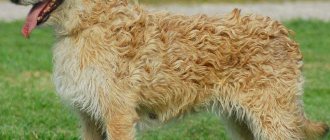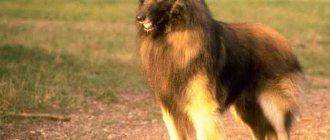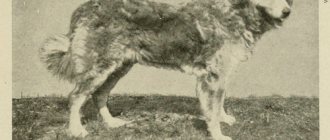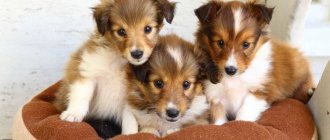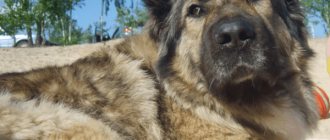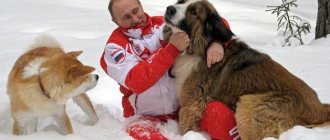| Origin | Belgium |
| Usage | Security guards; shepherds |
| Color | Shades of red color; on the face the mask is a darker shade than the main color. |
| Dimensions | Height (cm) 56-65; male Malinois weight (in kg) 27-30, females from 20 to 26 kg. |
| Lifespan | up to 14 years old. |
In search of a reliable and faithful friend, you should look at the Belgian Shepherd and become familiar with the subtleties of character and behavior. Belgian Shepherds are divided into four subspecies: Malinois, Tervuren, Groenendael, Laekenois. Separately, the Malinois is noted as an example of fidelity and grace. The ability to learn allows it to be used in such areas as rescue and search work, service in law enforcement agencies.
Breed standard
The Belgian Malinois is a harmoniously developed animal with a proportional build. The original breed standard, dated 1892, was set uniformly for all Belgian Shepherds: one species, varying in coat type. It was only in 1907 that a decision was made to divide the Belgians into 4 subspecies, differing in coat type and color: Malinois (short-haired); Laekenois (wire-haired); Groenendael and Tervuren (long-haired).
The table below describes the Malinois breed standards.
| Options | Description |
| Head | Elongated shape. The length of the muzzle is equal to the length of the head. |
| Frame | Powerful yet lightweight. The height at the withers is equal to the length of the body. |
| Muzzle | Elongated wedge-shaped. The nose is black, the nostrils are wide. |
| Ears | Triangular ears with strong cartilage, point straight up. |
| Neck | Muscular, elongated, widening towards the shoulders. |
| Eyes | Almond-shaped eyes, non-protruding, from light brown to dark chocolate color. |
| Bite | Scissor-shaped or pincer-shaped. |
| Malinois colors | Red coat color all over the body with a dark mask on the muzzle. Dark overlay - each hair at the tip is colored black, spread throughout the body. |
| Wool | Short, dense, harsh with medium undercoat. |
| Tail | Thick at the base, tapering towards the tip. Saber-shaped, not rising above the level of the body. |
| Limbs | The forelimbs are powerful, with well-developed bones. Not twisted. The hind limbs are muscular and strong. |
| Paws | The fingers are gathered into a ball, the claws are dark and hard. |
| Movements | The movements are active, more running in a circle than in a straight line. All limbs move at the same level, without standing out. |
Signs according to which rejection occurs:
- Increased aggression or cowardice.
- Undershot or overshot.
- Drop ears.
- Tail docked at birth or during life.
- Curling tail.
- No mask on the face.
- White spots on the body.
Each dog has a unique mask, which can be seen in the photo of the Malinois shepherd dog.
History of the breed
The history of the Belgian Shepherd is not that ancient and dates back just over a century. Shepherd dogs that helped herd and protect herds of sheep were known in Europe back in the 17th century, but no one was involved in the purposeful breeding of breeds in those days. Peasants bred dogs, paying attention to the professional qualities of the animals, without attaching any importance to their exterior. By the middle of the 19th century, a huge number of herding dogs with a wide variety of colors and coat quality were bred in Europe.
In the second half of the 19th century, a Belgian professor of veterinary medicine named Adolf Reil decided to develop a special breed of herding dog that could claim the title of national dog. The professor selected medium-sized dogs of the same type with erect ears, but varying lengths and coat quality. The professor strongly recommended that all breeders focus on the quality of the wool when breeding the breed. Selection work under his leadership lasted more than 20 years, however, its direction has changed somewhat compared to the original plans. The team of breeders paid a lot of attention not only to the quality of the animals’ fur, but also to its color. As a result, 4 varieties or breeds of the Belgian Cattle Dog were born, each of which was named after the place where it was bred.
In the town of Groenendael, the Groenendael breed was bred: a long-haired black shepherd dog. A long-haired type of shepherd dog with a bright red color, black markings and a mask began to be called Tervuren, in accordance with the place of residence of its breeder. And a dog with exactly the same color, but short hair, was bred in the city of Malin and received the name Malinois. The last type of Belgian Shepherd, the Laekenois, got its name from the location of the royal castle of Laeken. This type differs significantly from its relatives in appearance, is the smallest in number and is extremely rare.
In 1891, Professor A. Reil entered all 4 types of Belgians into the breeding register and formed the Belgian Shepherd Club. 16 years later, in 1907, the first standards were determined for each type of breed, which at that time established coat length and color.
Character
The Malinois has a balanced character. He is vigilant, not timid, and has innate protective qualities. Obedience and affection make him a loyal friend and companion. A lively and active dog needs an equally energetic owner. Without physical exercise, the Malinois can become aggressive, because the historical purpose of the shepherd requires a burst of energy. With proper upbringing, he becomes a full member of the family, a friend for children.
The Belgian Malinois is able to accurately recognize a person’s mood and the atmosphere in the house.
Will not tolerate rude treatment, indifference is a real punishment for the Belgian. Does not strive to be the dominant one in the family; he considers the owner to be the center of the Universe. The main characteristic of the breed is determination and efficiency.
Character and description of the Belgian Shepherd breed
Such a dog will not play with children, but, of course, it will obey and obey.
So, if there are children in the family, there is no need to worry, the Belgian Shepherd will become a friend not only to you, but also to the child.
This breed usually bonds with one person
. But he will not refuse the attention of other family members. A new person needs to be careful when meeting them, because the dog has a well-developed instinct of hunter and protector.
The Malinois is highly trainable
, but in order to accustom her to being around other animals, you will have to make a lot of effort.
Even a very well-mannered and trained pet will not be able to deny itself the pleasure of chasing cats. Therefore, you should be careful if there are other animals in the family.
Even beginners can train a Malinois. So go here and see how easy it is to learn basic commands.
Application
The Belgian Malinois is a hardy, strong animal. Adapted to various weather conditions, it is not afraid of rain, heat or cold. The Malinois is considered the most adapted to harsh conditions compared to other Belgians. After all, dogs were originally bred to help herd and guard livestock. Over time, these qualities improved, and the most productive individuals were selected for further breeding. Such qualities as resistance to stress, sociability, and gentleness were valued.
Modern Belgian Malinois dogs are divided into two groups: working dogs and ring participants. Working dogs are used in the service of law enforcement agencies. Their help in searching for missing people, in police service, and security is invaluable. Ring dogs are also hard workers, but in a different direction. Participation in sports competitions and exhibition shows fully demonstrates the dog’s capabilities.
History and origin
The ancestors of Belgian Shepherds are herding dogs, many of which ran around Europe from the 17th to the 19th centuries.
Shepherd dogs were excellent for such work and were herding dogs - in English a shepherd dog is called SHEEP DOG, which translates as “sheep dog” or “dog with sheep.” Such dogs had excellent working qualities, easily collected animals in one pile, and, if necessary, could protect them from wild animals. In 1891, in Brussels, shepherd lovers organized a club called “Club du chien de berger belge”. After some time, an exhibition was held there, to which many shepherds came to show off their pets and find a pair for mating. 117 dogs were presented at the exhibition and 40 of them, after a thorough examination, were recommended for further breeding. At the same time, the breed was divided into several varieties, one of which was the Belgian Malinois Shepherd.
This variety of Belgian Shepherd is named after the small town of Maniles. The ancestor of the Malinois is considered to be a short-haired, but not wire-haired male named TOMY.
Today, Belgian Malinois dogs work successfully in all special services. They serve in the army and police, help search for people and chemicals, and can also serve as excellent guides. Thanks to their characteristics, they even began to slightly displace German Shepherds in Germany.
Socialization
Socialization is the level of a dog’s comfortable state of health in a particular setting or situation. If a Malinois dog lives in an urban environment, then such qualities as not being afraid of city noise, transport, lack of aggression towards large numbers of people, and an indifferent attitude towards stray dogs and cats are instilled.
The dog requires early socialization to develop its character, otherwise it will grow up suspicious and aggressive.
Animals in rural areas need to be socialized more than their urban counterparts. Especially if the dog is planned to be exhibited in the future. A Malinois sitting behind a fence, not seeing anyone except members of the household, will not be able to behave adequately in the ring if it finds itself in an unfamiliar environment.
The first activities are carried out after scheduled vaccinations. They begin to take the puppy to quiet places. Each time they increase the walking area, introducing them to new surroundings. Once the puppy has established contact with its owner, you can move on to the next stage—meeting other dogs and people.
How to choose a puppy
When choosing a puppy for an exhibition, you should prefer those nurseries that can boast of achievements in exhibition activities. Future ring champions and participants in various show programs are bred here.
A decent breeder is always ready to make contact with the future owner of the puppy, will tell you everything about the Malinois breed, and give advice on care and maintenance. The main condition is that the puppy, like his mother, must look healthy: moderately well-fed, eyes, nose and ears free of purulent discharge. The coat should cover the entire body evenly, without bald spots. A healthy puppy has a good appetite, so it’s worth trying (with the breeder’s permission) to feed him.
The baby goes to a new home at the age of 8-9 weeks. At this point, the first series of scheduled vaccinations has already been done, and the puppy has begun to try “adult” food. To prevent the Malinois puppy from being sad, you need to take with you something with the smell of its mother: a bedding or some other rag. This makes it easier for him to cope with the stress of moving.
It is not recommended to buy a puppy secondhand at bird markets or through private advertisements. No one will give any guarantees regarding breed and health status.
Features of maintenance and care
Shepherds are working dogs. It is better to keep them in a private house with a spacious yard or area where the dog can run freely. They adapt well to living in city apartments. In this case, the owner must devote more time to walking the pet. The peculiarity of the breed is that a Malinois sitting idle for too long can become irritable and aggressive.
Grooming
Grooming procedures can be carried out at home, which significantly saves the family budget.
- Grooming
The Malinois' coat is easy to care for - comb out during shedding with a fine-toothed comb, and periodically wipe the surface of the entire body with a damp cloth. These manipulations are enough.
- Nail care
Trim as it grows. Usually once every 2-3 weeks.
- Ear care
Once a week, wipe the inside surface from dust and dirt. During the period of tick activity, inspection for their presence is necessary. A dog that spends most of its time outside is examined daily. To treat an animal against parasites, sprays are used that repel ticks and other blood-sucking insects.
Bathing
The dog was bred to live outside, so it does not need frequent bathing. It is enough to wash once every 3 months. Its fur has dirt-repellent properties. Of course, when you come back from a walk in rainy weather, you wash your paws. The animal is accustomed to this procedure from early childhood. In summer, swimming in open water is recommended; there are no restrictions. Malinois usually love to swim in the river or sea.
Walk
In order not to lose physical shape, the animal needs long walks and significant physical activity. The Malinois needs this vitally. Loves ball games, frisbee (games with a flying disc), agility (overcoming various obstacles). Any active actions delight the Belgian. You won't find a better companion for long hikes.
Feeding
Proper nutrition from an early age will allow you to raise a healthy and harmoniously developed dog. The Malinois needs a balanced diet that will satisfy the animal's need for all nutrients. Overfeeding, as well as underfeeding, may in the future result in problems with metabolism and the functioning of the reproductive system.
An adult dog is fed twice a day. Products included in the Malinois' natural diet:
- Meat.
- Roots.
- Cereals.
- Fermented milk products.
- Fish.
With a natural diet, you need to periodically provide a multivitamin supplement.
The drinking regime is calculated based on the dog's needs. An adult dog has 40 grams of water per 1 kg of animal weight. Young animals need 80-90 grams of fluid per 1 kg of weight.
Eating industrial food (dry, canned) gives confidence that the pet is fully provided with all the vitamins and nutrients that fully satisfy the dog’s needs. The value of ready-made dry food is that it is easily selected according to the dog’s age, and also corrects emerging diseases.
Classification of dry food:
- For puppies.
- For adult animals.
- For nursing bitches.
- For older dogs.
- Hypoallergenic food.
- Food that improves digestion.
Belgian Shepherds: maintenance, training, care
If you have a Belgian Shepherd puppy in your home, you will have to be patient. Puppies are very mobile, active and unusually curious. Moreover, representatives of this breed mature very late, by the age of two, but remain curious fidgets throughout their lives. Hence the conclusion: the sooner you start raising a pet, the more things will survive in your home.
Like adult Belgian Shepherds, puppies pick up everything on the fly. At first, in raising a baby, you should focus on the basic rules of behavior in the house: where to sleep, where to play, where to eat. It is very important to gently explain to your pet what not to do, especially if the puppy does get into trouble.
Proper care of a Belgian Shepherd means, first of all, caring for its coat, especially if you keep a Groenendael or Tervuren breed.
Long-haired dogs need to be brushed twice a week. First, with a wide-tooth comb, and then with a special brush: this procedure removes dead hair and massages the skin well. During molting, the animal will have to be combed more often. During the warm season, you need to take extra care of your fur so as not to catch ticks.
Malinois dogs shed constantly, so to keep their coat looking beautiful and well-groomed, they should be brushed with a special brush several times a week.
It is easier to feed your dog with dry special food: it has a well-balanced ratio of proteins, fats and carbohydrates. Dogs are usually fed 2 times a day: in the morning, giving 30% of the daily food intake, and in the evening, giving the remaining 70%. If you keep a long-haired pet, then you need to add special microelements to the food that improve the structure and quality of the coat.
Training a Belgian Shepherd, as already mentioned, is not difficult, but it requires system and consistency. The dog should always be trained and trained, feel the firm hand of the owner. Otherwise, the animal may become uncontrollable.
At the age of 2-4 months, your puppy should be engaged in mental exercises twice a day, devoting at least 15-20 minutes to each lesson. For physical activity at this age, simply playing is enough. At the age of 4-6 months, the time for mental training should be increased to 30 minutes and half a kilometer jogging should be added. From 6 months, training should be carried out 2 times a day and take at least 40 minutes.
From the age of one year, the dog must run at least 1.5 km daily.
Shepherd dogs are extremely loyal and devoted to their owner, but at the same time they are proud animals with a sense of their own dignity, therefore rough treatment, especially physical punishment during the training process is unacceptable. In this case, the result will be disastrous: the dog will either become cowardly and downtrodden, or turn into an aggressive and unbalanced animal. Training should be carried out exclusively by persuasion and encouragement.
Health
The Belgian Malinois is considered one of the healthiest breeds: it is suitable for outdoor living and is not susceptible to colds. With proper care, a dog can live up to 14-15 years, while maintaining its working qualities for up to 10-12 years.
Diseases
Common diseases include food allergies. Also, due to improper nutrition and lack of exercise, the dog may become obese.
Vaccinations
Routine vaccinations are required for Malinois just like all dogs. No animal is immune from such life-threatening diseases as plague and rabies. Vaccinations performed strictly according to an individual schedule will reduce the risk of disease.
The first standard manipulations are carried out at 2 months of age. The puppy is first treated for fleas and worms: the presence of parasites can negate the effectiveness of vaccinations. In the table below you can see the planned immunization activities.
| Disease | Vaccination procedure | Revaccination | Next vaccination |
| Rabies | 12-13 weeks | At 12 months | Annually |
| Hepatitis | The first vaccination is at 8-10 weeks, the second after 3-4 weeks. | At 12 months | Annually |
| Plague | The first vaccination is at 8-10 weeks, the second after 3-4 weeks. | At 12 months | Annually |
| Parvovirus | The first vaccination is at 8-10 weeks, the second after 3-4 weeks. | At 12 months | Annually |
| Microsporia | 1-6 months | In 2 weeks | Annually |
Health and susceptibility to disease
The average lifespan of a Belgian Shepherd is 12–15 years. They have good health, which can only be disrupted by genetic tendencies and errors in care and maintenance. More often than others, they exhibit the following diseases:
- dysplasia of the elbow and hip joint;
- cataracts and retinal atrophy;
- gastric volvulus;
- epilepsy;
- hormonal disorders;
- skin diseases.
To avoid health problems, you need to provide your pet with proper and balanced nutrition and the most active lifestyle possible. Do not forget also about regular visits to the veterinarian (at least once a year) and all necessary vaccinations.
The Belgian Malinois is a strong and working dog that is excellent for protection and intelligence work. You should only get such a pet if you are sure that you can pay attention to it, spend a lot of time with it, and actively engage in training and education. With the right approach, you are guaranteed to receive a loyal friend and reliable protector.
If you find an error, please select a piece of text and press Ctrl+Enter.
Mating
The best age for the first mating of both a female and a male is 1.5-2 years. To find a suitable partner, contact the nursery. There you can choose the best copy. The dogs are walked before the meeting; there is no need to feed them. The “bride” arrives at the “groom’s” territory. Malinois usually knit on their own and do not need human help. To consolidate the result, it is recommended to repeat mating after 1-2 days.
Matings between different types of Belgian Shepherds are prohibited.
How much do Malinois puppies cost?
To purchase a puppy with a good pedigree, you should contact a nursery. The price for working dog puppies will range from 35 to 50 thousand rubles. For puppies intended for show shows, the price can reach 60 thousand rubles.
Sometimes puppies appear in nurseries with traces of defects, due to which the dog cannot participate in exhibitions and breeding in the future. Such puppies are given away almost for nothing. If you need a dog to guard your home, or just as a friend, without plans for a show future, then you can take it without a pedigree.
Nurseries
Malinois (Belgian Shepherd) is the most popular dog for service in the police and army, in disaster medicine units. Thanks to its high sense of smell, it is the best assistant in searching for people and detecting narcotic and illegal substances. A dog whose life without work is impossible. Malinois puppies purchased from professional nurseries have every chance of becoming ring champions.
Vyatkina nursery https://working-malinois.com/
Service dog nursery https://www.freiwind.ru/index.html
Faithful, selflessly devoted, ready to come to the rescue at any moment, and at the same time affectionate dog - the most suitable description of the Malinois breed. An ideal companion for sporty and socializing people.
Interesting stories
In 2021, which is considered the year of the dog according to the Chinese calendar, a short film “A New Year's Story Told by a Malinois” was prepared. The main role is given to this wonderful dog, and the story is told from her perspective. The film was created with the participation of the Russian National Guard film studio.
photo of dog
Another example from the film career of four-legged Belgians. In 2015, the film “Max” was released, telling about the difficult fate of the Malinois. While serving in Afghanistan, he loses his friend and partner Kyle. After suffering stress, the dog cannot perform combat missions, and the military believes that the animal must be euthanized. But Kyle's family decides to take Max for themselves. This film is about how Max learns to exist in a world without bombings and shootings, about friendship and loyalty.

